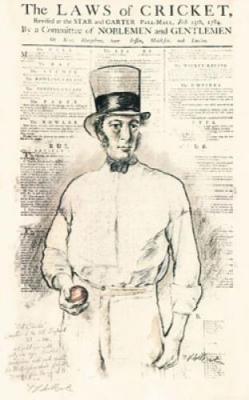The rules that govern the game of cricket can be found in the ‘Laws of Cricket’ from The Official MCC Website.

What we typically think of as the rules of cricket are in fact a set of laws that are overseen by the MCC ( Mareylebone Cricket Club) in London, for more on this go to the section on the history of cricket.
The MCC are the framers of cricket’s laws.
These rules or laws as they are known have evolved over hundreds of years, going back to what is believed to be the the first known records of the game in England, in the middle ages.
In 1299-1300 it is recorded in the Royal Wardrobe Accounts for the then Prince Edward the II, to play ‘creag’ and other games.
It is too tenuous to suggest that ‘creag’ is the game that cricket is based upon, but games like ‘creag’ and ‘criquet’, a variation of club ball, (a game that Edward the III had sought to eradicate in 1369), are believed to be the early origins of what we now know as cricket.
In 1744 the rules/laws of cricket had been codified and in 1788 were revised by the Marylebone Cricket Club, they covered the length of the pitch, the distance between creases, wicket size, and ball weight.
The MCC version was not immediately accepted, nor necessarily applied with any consistency, but over time they became the standard by which clubs and counties began to apply rules to the game.
The codification and revisions in 1744 and 1788 are the foundations of the rules of cricket that are applied universally throughout the cricketing world today, they are amended when it is appropriate to keep pace with the game’s development.
Major changes were brought in to accommodate players wearing pads and ( the LBW law ) and over arm bowling.
On 1st October 2010, a new edition of the Laws of Cricket came into force. This edition, known as the 2000 Code 4th Edition – 2010, is displayed on the MCC website and is the most up to date version, for use in all competitions.
Spirit of Cricket
Since the introduction of the 2000 Code, the Spirit of Cricket Preamble has been an important feature, providing the context in which the game is intended to be played.
Learn more about the Spirit of Cricket and MCC’s initiatives to promote it.
MCC’s Open Learning Manual is a comprehensive guide for umpires and students of the Laws who want to gain a better understanding of the Laws and their application.
This document is available to download here.
 The Laws of Cricket cover :
The Laws of Cricket cover :
Law 9 : The Bowling, Popping and Return Creases
Law 10 : Preparation And Maintenance Of The Playing Area
Law 14 : Declaration And Forfeiture
Law 16 : Start Of Play; Cessation Of Play
Law 17 : Practice On The Field
Law 29 : Batsman Out Of His Ground
Law 37 : Obstructing The Field
Index to The Laws
The Archaic Laws Of Cricket
History: Law 36 – LBW
Playing Conditions: Balls per Over in all FC and Test Cricket
Laws of Blind Cricket
